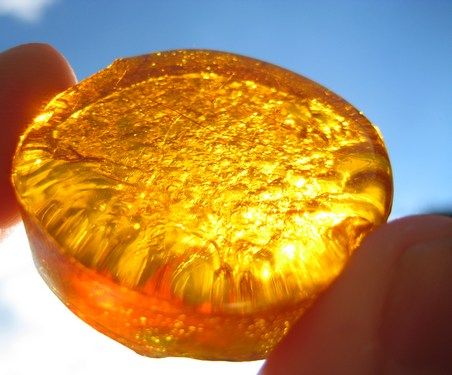 |
| A block of rosin. How it glowses, my precious! |
This is uncharted territory for me, I've never clapped eyes on "rosin based" sealant before. From various sources dotted about the web, I gather it's rosin dissolved in castor oil, heavy on the rosin. That's about as much as I know. Any right thinking amateur would reach for a credit card at this point, but to the best of my knowledge, there is no domestic UK source of premixed rosin based sealant. US based Main Street Pens springs to mind as an easy solution for American readers (or if you can think up a few more things to make international shipping worthwhile).
To begin with, I was dead against having to stock up on anything in bulk. If that had been necessary, I would honestly have preferred to just buy a handy 10ml vial, treading a big ugly carbon footprint from New York to Glasgow. I have exactly one drawer for pen-type tools - well, two, if you count the spark plug pliers (they've yet to meet any spark plug boots). There's no space for a litre of castor oil!
Ingredients
For £2.48 including postage, eBay seller Aina TM provided 11ml of "Organic Castor Oil BP" (amongst a jungle of unintelligible pharmaceutical properties, this variant seems to have lower acidity), while a 4cm diameter disc of 'Theodore' violin rosin cost £1.88 from DJMusic.
 |
| Rosin, check. Castor oil, check. |
Preparing a glass storage vial
I had just the thing to store the potential sealant in - a 10ml glass vial, with an integrated application brush. This originally contained shellac, but what little that was left had long since gone off. An overnight soak in methylated spirits made light work of the shellac residue, and in turn, an overnight soak in soapy water made light work of the methylated spirits smell (I can't stand it).
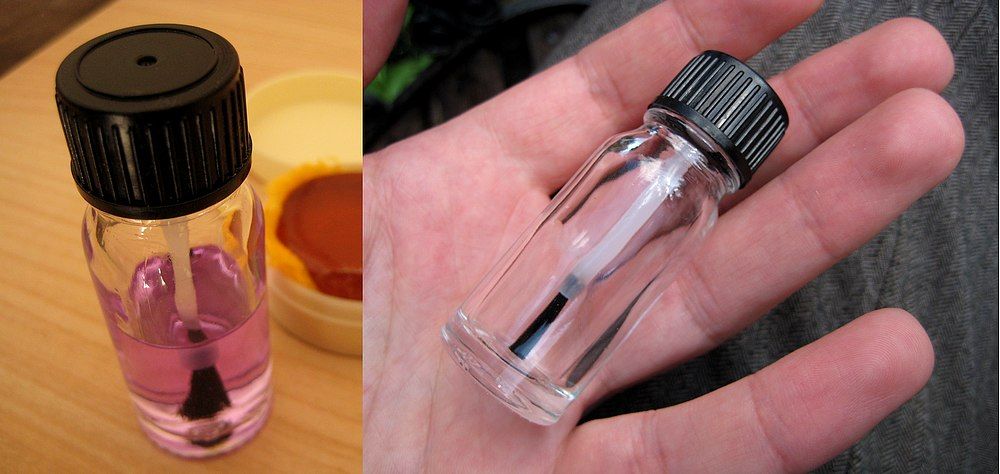 |
| Cleaning, and clean. A 10ml glass vial with screw-cap and application brush. |
I added an O-ring to help keep the vial air tight. Weirdly, there is a recess in the plastic cap ready for a rubber gasket to fit into place, but it didn't come with one installed.
 |
| Adding a cap gasket. |
Breaking Down the Rosin Cake
This is a 4 centimetre diameter cake of "Theodore" violin rosin, bought specifically for its hypnotising amber radience, and the seller's mention of this variety's "slightly sticky interior texture offering plenty of grip". I found that rubbing the blade of a craft knife against the cake easily shaved the surface down to a fine powder, which could be poured into the glass vial.
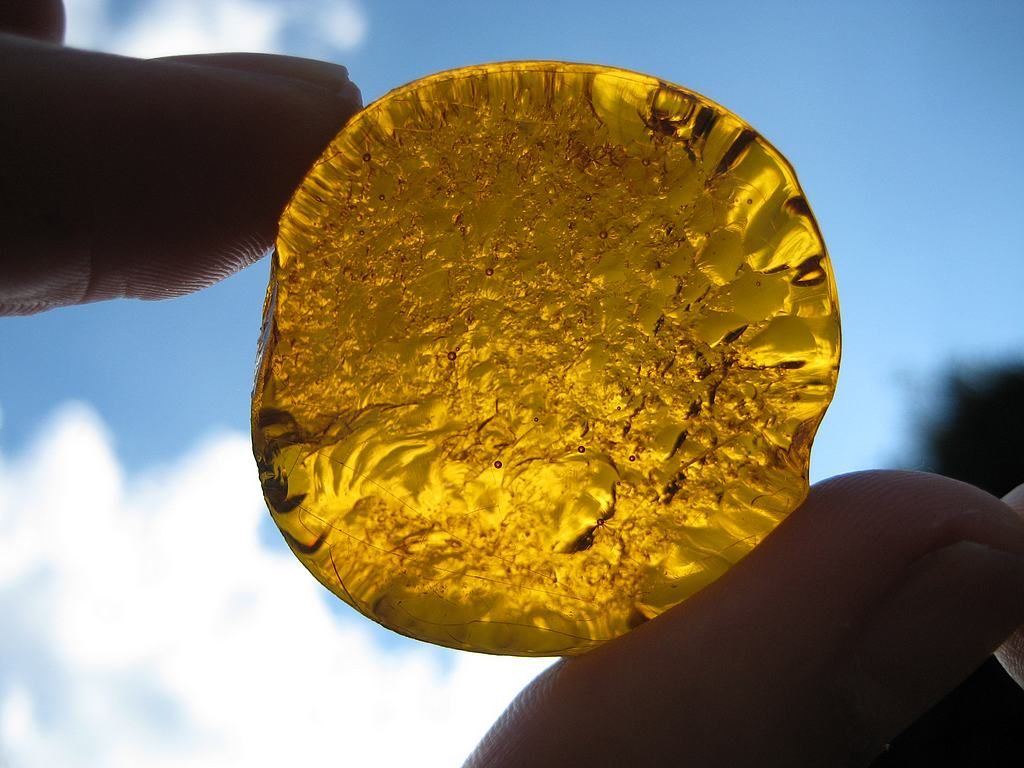 |
| "Theodore" violin rosin. Not quite double-rainbow awesome, but still quite captivating. |
As this step was bound to make a mess, I broke down the rosin in a piece of baking foil. This made a decent funnel too, for pouring the powdered rosin into the glass vial.
 |
| Breaking down the rosin, and filling up the vial. |
Mixing In Castor Oil
The ratio of rosin to castor oil I was aiming for was 60-70 percent rosin, by volume. I came across that figure by way of a link in a great FountainPenBoard thread. That gem of a hint had been preserved in an abandoned, late '90s, Times-New-Roman-with-some-Hyperlinks type page still maintained by Syracuse University. It really kick-started this endeavour, so my thanks go out to a certain Vincent Fatica, who included an informative sojourn into the background and preparation of rosin sealant with his own recollections of making the stuff. Prior to reading this, the only other clue I had to work off was a mention of rosin based sealant being more viscous than shellac, which I had to hand as a gloopy frame of reference.
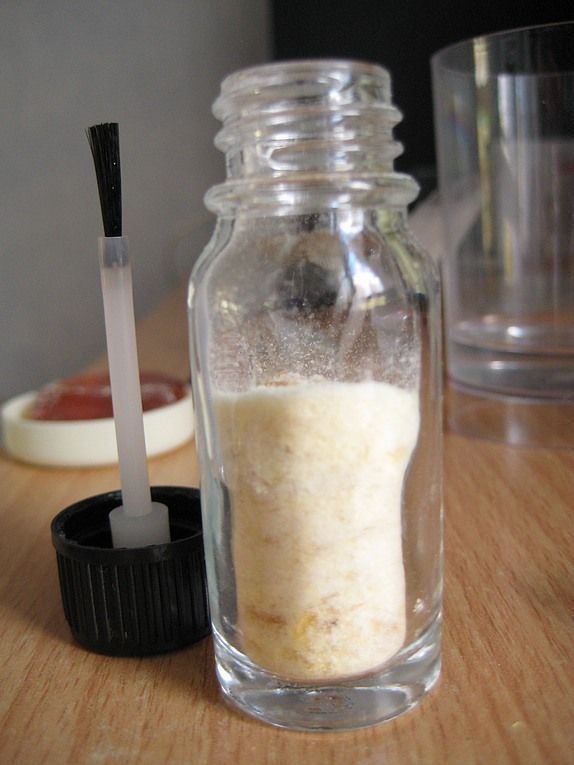 |
| About to pour in some castor oil. |
Anyhoo, I reached over to the bottle of castor oil, squeezed the integrated eyedropper, and started mixing a squirt into the rosin powder, using a large darning needle. I figured if I didn't get the rosin wet enough beforehand, heating it up would just melt it into a lump and I'd be back where I started.
To help the mixture heat evenly, I sat the vial in a hot bain-marie, over a medium flame. This had the unfortunate effect of fogging the camera lens in short order! The overturned foil pudding cup in the photos below was just a precaution against the vial tipping over in the bubbling water.
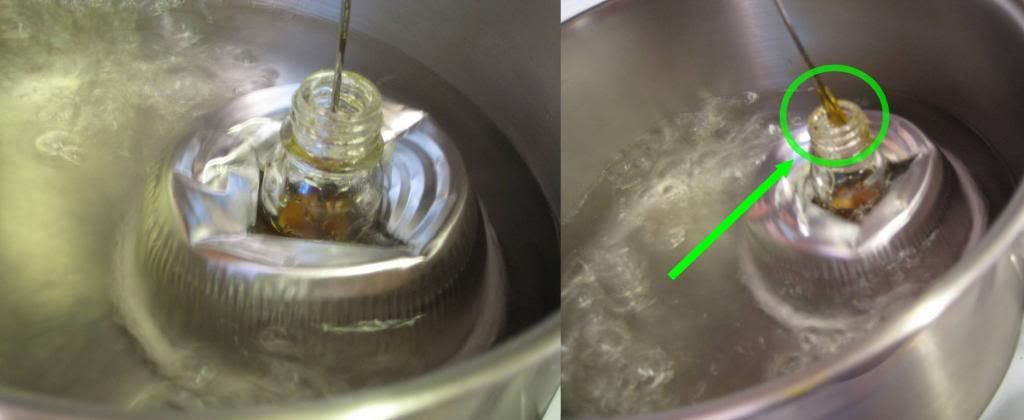 |
| Heating the rosin/castor oil mix (I left the darning needle in situ). Arrowed - checking texture. |
After cooling, I noticed the sealant was still quite thick. If inverted, it takes quite a while longer than the shellac to shift from the top of the bottle to the bottom (as arrowed in the photograph below).
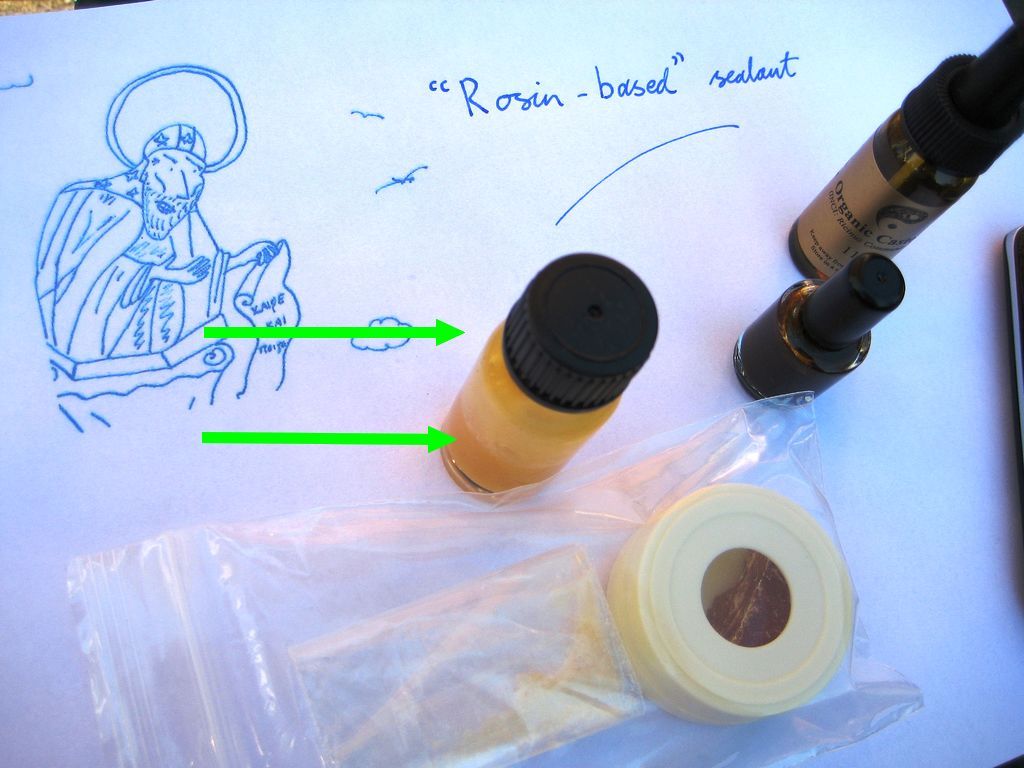 |
| Arrowed - rosin based sealant, slowly shifting from the top to the bottom of the bottle. |
Well, does it work?
I'll leave the vial alone overnight, and if it's still liquid enough tomorrow, try it out on some ballpoints before moving onto to fountain pens. I'll keep you posted!
Thanks, No Thanks!
Thanks!
Hugely helpful sources I used as a guide. Thanks all.
Hugely helpful sources I used as a guide. Thanks all.
No Thanks!
Blogger, I'm still having to paste break codes into photo captions by hand. It's no longer endearingly retro, you fellows!
Blogger, I'm still having to paste break codes into photo captions by hand. It's no longer endearingly retro, you fellows!
Did it work?
ReplyDeleteNot this batch! But if you click 'Newer Post' down there near the bottom of the page, or choose the next post in the blogger archive menu to the left, you'll see subsequent attempts that worked much better.
DeleteHi, I tried the recipe and it didnt work for me, I used 2g rosin to 6g castor oil and strange it didnt looks like a glue to me, mine was dissolved at he heat, however it was thin. would you mind sharing ratio of rosin:castor oil on weight if possible.
ReplyDelete